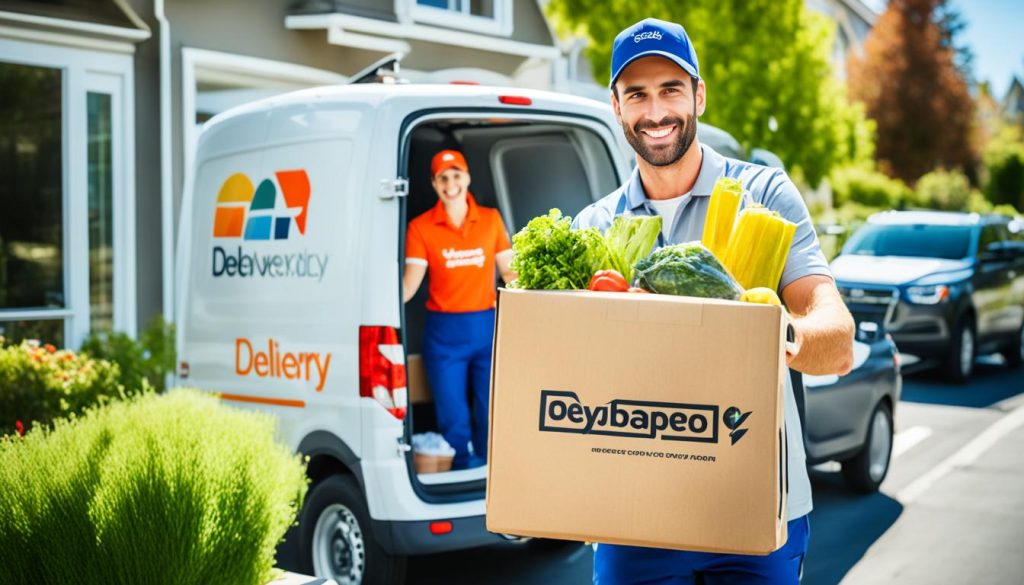Starting a grocery delivery service is a great business idea. It blends customer ease with today’s online shopping trend. This sector is expected to grow huge, reaching US$782.40 billion by 2024. It’ll grow even more, with a 12.03% increase each year till 2029.
This growth shows a bright chance for newcomers wanting to start their own service. A home delivery grocery business leverages the rising need for convenience. It also dives into the thriving start-up world of food delivery.
Introduction to Grocery Delivery Services
Grocery delivery services make it easy to have groceries delivered to your home. This avoids the need to go to the store. They suit busy people who prefer shopping online for their daily needs. With more people wanting easy shopping, more are using these services.
What is a Grocery Delivery Service?
A grocery delivery service lets you order food online and delivers it to you. You don’t need to go to the store yourself. These services can be standalone or work with supermarkets.
Why Start a Grocery Delivery Business?
Starting a grocery delivery business can be very rewarding. It meets the growing demand for getting groceries easily and saves time. It’s a good way to serve people who value convenience. This meets a big need in today’s fast-paced world.
Choosing the Right Business Model
Choosing the right business model is crucial for setting up a successful grocery delivery service. We look at three main types: Marketplace, Fulfilment Centre, and Hybrid models. Each one offers unique benefits and requires a specific strategy for success. Understanding these will help in making the most of online grocery sales opportunities.
Marketplace Model
The Marketplace model connects vendors with consumers through an online platform. It lets different retailers offer their products in one place. This diversity means customers can find almost anything they need. This model’s big plus is its low costs. This is because the sellers handle their own stock.
Fulfilment Centre Model
The Fulfilment Centre model is about managing the inventory by the service provider. A central location stores, manages, and sends out goods. Having a strong plan in this setup guarantees that products are always available and of good quality. It requires more money and effort to start but gives more control and can boost customer loyalty with fast and reliable service.
Hybrid Model
The Hybrid model mixes elements from both the Marketplace and Fulfilment Centre models. It combines a wide range of products with the ability to oversee some items directly. This model offers flexibility and low risk, plus quality control and quick delivery. By blending the best of both worlds, companies can offer a stronger and more flexible service.
Conducting Market Research
Carrying out thorough market research is key to a successful grocery delivery service. It involves looking closely at different areas to meet specific needs and likes of consumers.
Understanding Local Demand
Firstly, find out how much demand there is in your area. Knowing about the people and their buying habits helps tailor services better. Using surveys, focus groups, and social media polls gives great insight into customer desires and issues.
Identifying Competitors
It’s vital to know who you’re up against in the grocery delivery market. Look at both established and new services to see what they offer. Focus on their pricing, delivery speed, range of products, customer feedback, and how they market themselves. From their wins and losses, you can learn how to stand out and avoid making mistakes.
Spotting Market Gaps
Finding what’s missing in the grocery market can set you apart. Look at the current services and see what they lack. This might be a need for more product types, faster delivery, or a more personal shopping experience. By addressing these gaps, you can satisfy specific needs and grow your business.
To sum it up, good market research for grocery delivery means understanding local demand, analysing competitors deeply, and spotting what’s missing in the market. This approach ensures your service goes beyond what’s expected, making a big impact in the market.
Crafting a Solid Business Plan
Creating a good business plan is vital for starting a strong grocery delivery service. It will guide your efforts, showing the path and goals. Let’s look at what you need for a great grocery delivery business plan.
Defining Business Goals
Setting aims is crucial for your plan. Be clear about what you want to achieve soon and later. Your goals should be SMART: specific, measurable, achievable, relevant, and time-bound. This approach makes sure every target moves your business ahead.
Target Market Analysis
Finding out who your customers are and what they want is key. Look into their buying habits and preferences. Use surveys, focus groups, and market data to get a full picture. This helps you serve them better.
Marketing Strategies
Your marketing should show why your service is special. Mix digital and traditional ways to tell people about your service. Use social media, emails, and local ads to get attention and attract customers.
Financial Projections
Showing your finances clearly is important for getting funding and planning. List your start-up costs, expenses, income, and profits. Update these numbers as things change to stay on track.
Include these parts in your plan to build a strong base for your grocery delivery service. This will help you grow and succeed in a competitive area.
Legal Requirements and Business Structure
Getting to know the legal requirements and setting up your grocery delivery service properly is key. It’s essential to get the right documents and follow the rules to avoid legal issues.
Obtaining Necessary Licences and Permits
It is crucial to secure the right business licences for your online grocery service. You must obtain various permits, like food handling and health safety. These are needed to operate legally. Also, keep these licences updated to meet local laws.
Choosing a Legal Entity
Choosing the right legal structure for your delivery service impacts taxes, liability, and how you operate. You can choose from a sole proprietorship, partnerships, and limited liability companies (LLCs). Each option affects your business in terms of legal and tax responsibilities. You’ll need to pick the one that matches your goals and how much risk you’re willing to take.
Insurance and Compliance
Knowing about compliance and insurance is crucial for your business’s protection. Having the correct insurance, like general liability and workers’ compensation, helps cover risks. It’s also important to conduct regular compliance checks and keep up-to-date with laws to protect your business from legal problems.
Budgeting and Funding Your Business
Starting a grocery delivery service involves careful budget planning for online delivery. You must make sure you have enough money to start and grow. It’s very important to know your starting costs and explore different ways to get money.
Estimating Initial Costs
When you start, carefully figure out the starting costs. Think about buying groceries and other items you’ll need. Investing in ways to deliver, like vehicles and places to keep things, costs a lot. Also, setting up a good app and website is expensive. Plus, you’ll need money to pay people like drivers and customer service reps.
Exploring Funding Options
Finding ways to fund your business is key. Your own savings might help at first. But, you might need to take out loans or use credit for bigger needs. Also, getting private investors can give you more money if you share ownership. Grants and special programs offer help too, especially for tech and retail ideas. Using all these ways to get money can make your business strong from the start.
Knowing how to handle your money well is very important. It helps you avoid early problems, run smoothly, and plan to get bigger.
Building Relationships with Suppliers
Having good partnerships with suppliers is key for a smooth grocery delivery service. It ensures we have a constant supply of high-quality products that meet what customers want. These partnerships involve working closely with a variety of suppliers, from local farms to big distributors. Keeping a balanced supply chain is vital for maintaining the quality and range of goods.
Building trustworthy alliances with suppliers not only streamlines operational processes but also fosters loyalty and mutual growth.
Good relationships with suppliers mean we can negotiate better and get fresh, varied groceries. This flexibility helps us quickly adjust to changes in the market. By valuing our connections with suppliers, we can always provide top-notch service and manage supply chain hiccups well.
- Consistent Quality: Reliable suppliers ensure the delivery of high-quality products, underpinning customer satisfaction.
- Reliability: Steady supplier relations fortify the supply chain, reducing the risk of stockouts and delays.
- Variety: Partnering with multiple suppliers expands the array of products available, catering diverse consumer preferences.
Strong supplier partnerships are crucial for any grocery delivery service. By maintaining these relationships and focusing on an efficient supply chain, businesses can offer a constant supply of good-quality products. This will help them stay ahead in a competitive market.
Establishing Efficient Inventory Management
In a grocery delivery service, managing inventory well is crucial. Using advanced inventory management systems helps track stock in real time. It also helps in managing orders and predicting future needs. This is key to avoiding having too much or too little stock.
Using Inventory Management Software
Technology is vital for keeping inventory in check. Inventory management software tracks stock levels accurately. It automates the ordering process and offers detailed reports on how products are doing. This helps keep the right amount of stock, making operations run smoothly and saving money.
Maintaining Product Quality
For grocery deliveries, especially with fresh items, it’s important to keep quality high. Implementing strict checking measures and continuous reviews are needed to keep standards up. Regularly checking quality, ensuring proper storage, and rotating stock help keep products fresh. This makes customers happy.
Hiring the Right Team
Building a successful grocery delivery service needs the right team. It’s crucial to figure out what types of employees you need. You should also focus on good training and efficiency programmes. This makes sure the business runs well.
Types of Employees Needed
For a delivery service, it’s vital to think about different key roles. Operational staff manage orders and stock, and delivery people make sure things get where they need to go on time and in good condition. Customer service reps are essential too, solving problems to make shopping smooth. Every role is key to keeping the service top-notch.
Training and Efficiency
Proper employee training in retail is key for boosting team productivity. Training programmes need to cover everything from how to handle products to using tech smartly. Holding regular training updates skills and knowledge. Plus, encouraging ongoing betterment means employees help with making things more efficient and innovative. This helps the business stay competitive.
Focus on getting and training the right staff for your delivery service. This can really help your team work better. And that drives the success of your grocery delivery business.
Developing a Marketing Strategy
A great marketing strategy is key for a grocery delivery service to do well. It’s important to use both old and new advertising methods. This helps gain and keep customers. Being active in your community and on social media will make your brand stronger.
Local Advertising Methods
Advertising locally can really help your business grow in the area. Use local papers, radio, and notice boards to share your service. Being part of events, supporting local teams, and handing out leaflets raises your profile. Sending mail directly to homes in the area can let people know what you offer.
Digital Advertising Techniques
Online ads are a must for reaching today’s shoppers. Spend on search engine and pay-per-click ads to be seen more online. Make your website easy to find in searches, for example, when people look for “grocery delivery services near me”. Email marketing is also effective. It lets you send deals and news straight to customers.
Social Media Marketing
Social media is perfect for getting attention for your business. Use Facebook, Instagram, and Twitter to talk directly with customers. Share special offers, sneak peeks, and happy customer stories. Paid ads on these platforms can attract the customers you want. Happy customers sharing their good experiences can really help spread the word.
Utilising Technology and Software Solutions
Modern technology is key to a grocery delivery business’s success. By using various software, companies can boost their efficiency and make more profit.
Delivery Route Planning Software
Timely deliveries and low operational costs rely on effective delivery route planning. With route optimization technology, businesses can make delivery routes more efficient. This cuts down on fuel use and boosts overall performance. Routific and OptimoRoute offer smart route plans that account for traffic and delivery times, making deliveries smoother.
Website and App Development
Having an easy-to-use website and app is crucial for a good customer experience. Investing in solid grocery delivery software makes ordering, tracking, and payments easy and safe. Platforms like Shopify, WooCommerce, and custom options ensure your online presence matches your brand and meets customer needs.
Customer Management Systems
Good customer management keeps customer satisfaction high. Using advanced customer experience platforms lets businesses handle customer interactions well. They can track orders and offer personalised services. With tools like Salesforce and HubSpot, managing customer relationships promotes loyalty through custom communication and efficient service.
Embracing these technological innovations helps grocery delivery businesses improve their service, streamline operations, and stay ahead in a busy market.
How to Start a Grocery Delivery Service
To start a grocery delivery service, first, plan your approach well. Use a detailed guide and follow industry tips for a strong start. It’s essential to be efficient, sustainable, and innovative.
Step-by-Step Guide
- Market Research: Learn about your customers and find what’s missing in the market.
- Business Model Selection: Pick from marketplace, fulfilment centre, or a mix of both.
- Legal Requirements: Get the right licences and choose your business structure.
- Budgeting and Funding: Work out your costs and look into funding options.
- Supplier Relationships: Build good relations with trustworthy suppliers.
- Inventory Management: Set up a strong system for managing stock.
- Technology Adoption: Use the best software to increase efficiency.
- Marketing Strategy: Create a solid marketing strategy to draw in and keep customers.
- Launch and Monitor: Start your service, watch how it’s doing, and make needed changes.
Best Practices
- Customer Relationships: Keep your customers coming back by building strong bonds. Excellent service and engagement are key.
- Service Standards: Always deliver on time and maintain top-quality products to gain trust.
- Innovation: Use new ideas to stay in front, like app development or custom services.
- Feedback Mechanism: Have a solid system to gather feedback and see where to improve.
- Scalability: Think about growing your business from the beginning without losing quality.
By taking these steps, sticking to best practices, and using a detailed guide, you can set up a successful grocery delivery business.
Challenges in the Grocery Delivery Business
Entering the grocery delivery market comes with its challenges. Whether you’re starting out or well-established, adapting is key. This ensures success and customer happiness in a competitive field.
Inventory and Product Quality Management
Handling inventory well and keeping products top-notch are vital. Employ systems to monitor stock in real-time and check quality often. This approach prevents running out of stock and ensures customers get fresh, high-quality items.
Efficient Route Planning
Planning good delivery routes is essential. Use advanced software for route optimisation to improve delivery times. It also cuts down on costs and fuel use.
Navigating Fluctuating Demand
Consumer demand changes often and is hard to predict. Use smart forecasting tools and adaptable staffing plans to stay prepared. This way, you can meet customer needs without stretching your resources too thin.
By tackling these key areas head-on, companies can better manage the complexities of delivering groceries. It leads to a seamless and pleasing experience for their shoppers.
Monitoring and Optimising Business Performance
Keeping an eye on performance is key in the grocery delivery world. It helps businesses grow sustainably. By monitoring closely, companies can decide how to outdo their rivals.
Tracking Key Performance Indicators (KPIs)
KPIs shed light on how well a grocery delivery service is doing. They cover delivery speed, order correctness, customer happiness, and more. Analysing these figures helps polish tactics for better efficiency and experiences.
Adjusting Pricing and Distribution Areas
It’s important to tweak prices and where deliveries go. Staying in tune with market trends and what customers like is key. This way, services stay profitable and meet people’s needs.
Conclusion
Starting a grocery delivery service opens up many chances in today’s market. There is a growing need for easy online shopping. This shows how promising this venture is. If entrepreneurs plan well from the start, they can build a strong base for their business. This includes doing market research, figuring out the business model, following the law, and finding good partners.
Entering the grocery delivery market needs a complete plan. This includes using the latest technology, building strong ties with suppliers, and having a good marketing plan. Paying close attention to these areas can make a business run smoothly. It can also beat customer expectations and lead to a successful, strong company.
In wrapping up this guide on starting a grocery delivery business, the right steps can make a business stand out in a tough market. If the business always aims to make customers happy, keeps getting better, and stays up-to-date with market changes, it can thrive. Success is likely in the ever-changing world of online retail.











